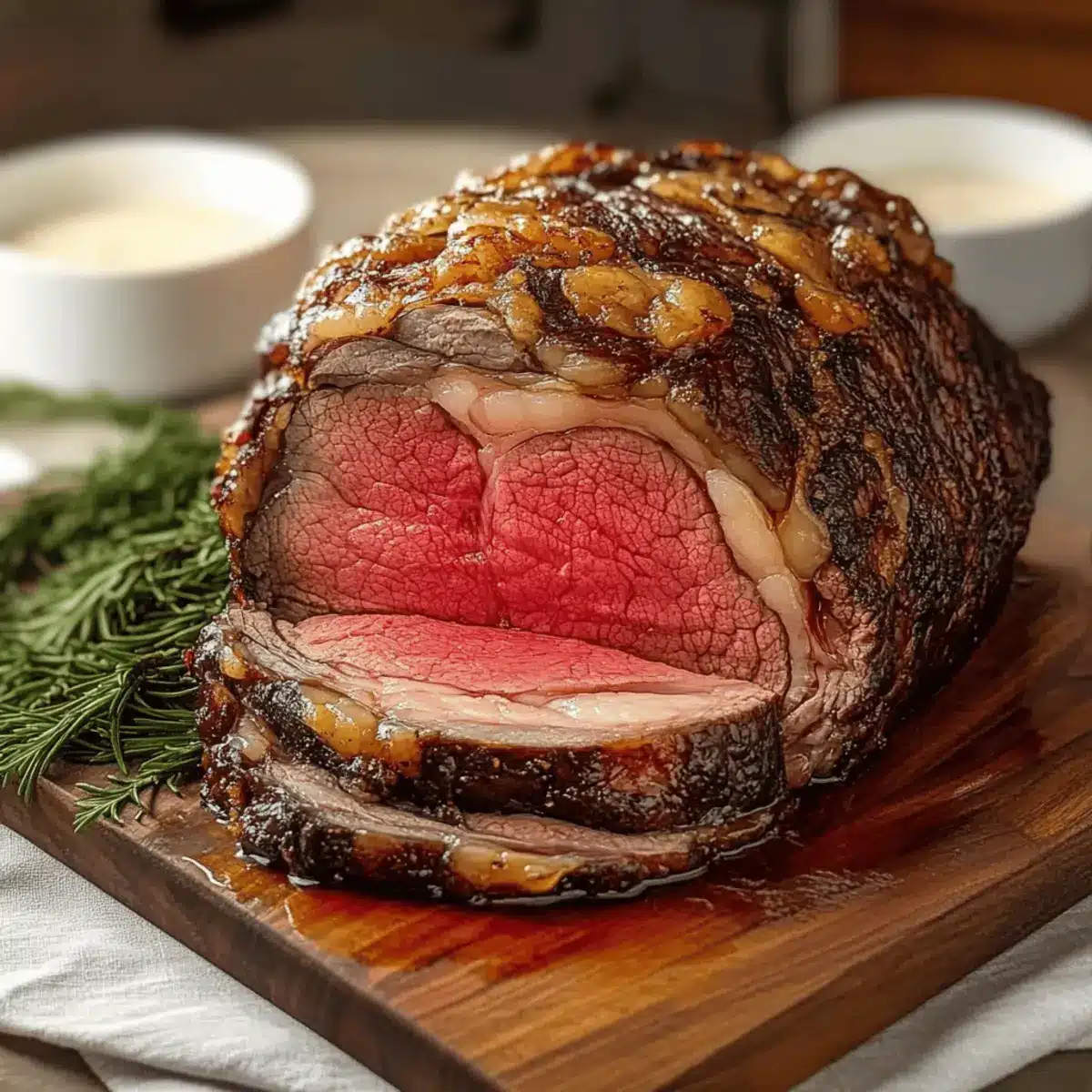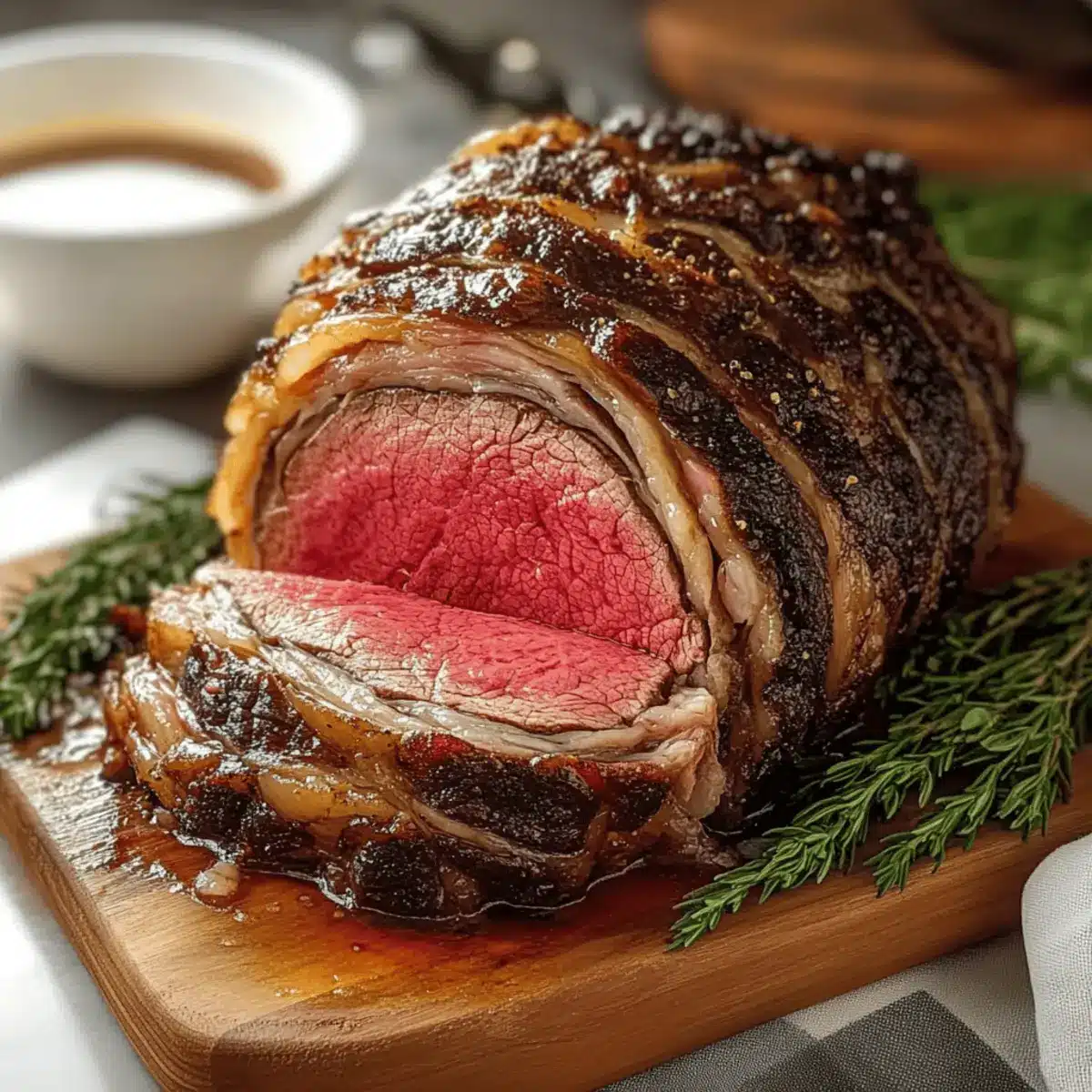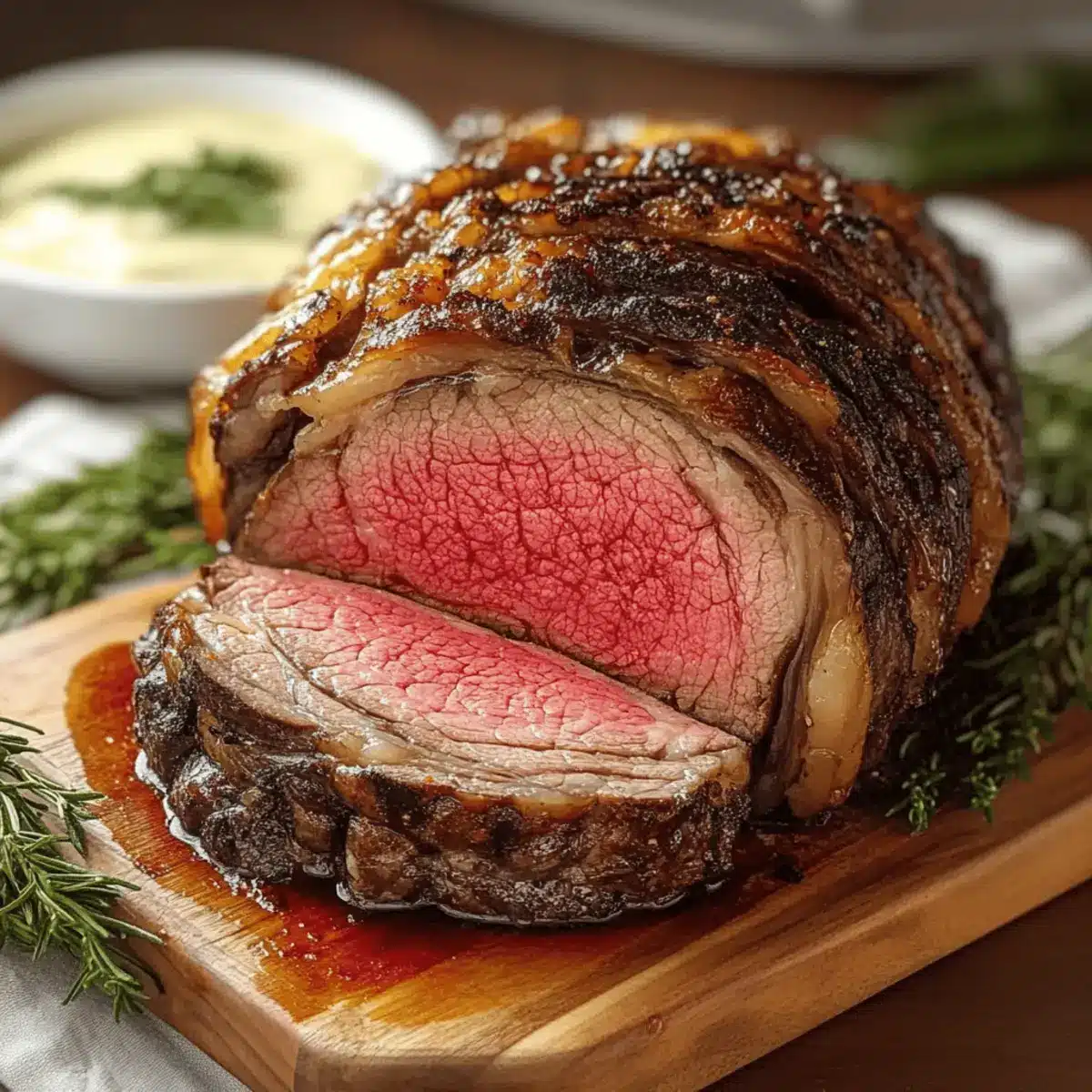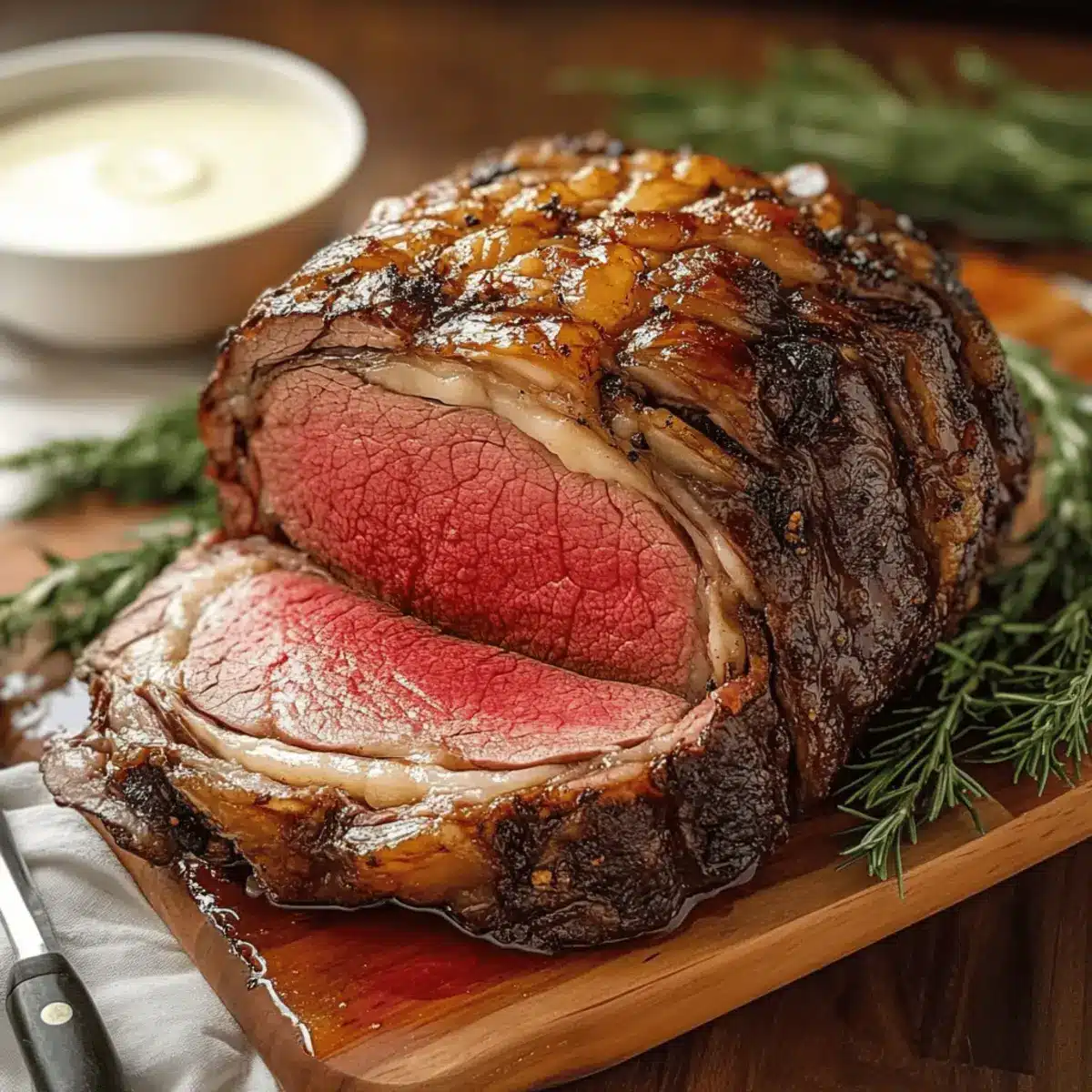Standing in my kitchen one chilly evening, the aroma of seared meat filled the air, igniting memories of joyous family gatherings. There’s nothing quite like the allure of a Reverse Sear Prime Rib—its crust perfectly golden and rich, while the interior boasts that irresistible rosy pink hue. This innovative cooking method not only ensures even cooking but also results in a remarkably tender roast that captures the essence of a celebratory meal. What’s more? It’s a cinch to prepare, making it a true crowd-pleaser for holidays and special occasions alike. Imagine impressing your loved ones with a dish that radiates warmth and comfort, all from the convenience of your own kitchen. Are you ready to elevate your cooking game and create the kind of memories that linger long after the last bite?

Why is Reverse Sear Prime Rib perfect?
Juicy Perfection: This method yields an incredibly moist roast, ensuring every slice is bursting with flavor.
Effortless Elegance: Impress your guests with minimal fuss—this recipe strikes the perfect balance between sophistication and ease.
Flavorful Crust: The reverse sear locks in juices while creating that delectable, crispy exterior everyone craves.
Special Occasion Delight: Ideal for holidays or celebrations, it’s the centerpiece your family will fondly remember.
Customizable Toppings: Personalize your dish with various herb rubs and sauces—experiment to make it uniquely yours!
Elevate your dining experience and check out my tips for making the best horseradish cream sauce or find out how to pair it with perfect sides like roasted vegetables!
Sear Prime Rib Ingredients
For the Roast
• Bone-in Prime Rib Roast – Choose a 4-6 pound roast for optimal flavor and tenderness.
• Kosher Salt – Essential for dry brining to enhance flavor; adjust if using table salt as it’s saltier.
• Freshly Ground Black Pepper – Use freshly cracked for maximum flavor and heat; it’s a must for seasoning.
• Garlic Powder – Adds depth to the roast; fresh garlic can be a tasty substitute if preferred.
• Onion Powder – Enhances umami; fresh onions can be used if you desire a more pronounced flavor.
• Dried Rosemary – Provides aromatic notes; crush before using to release more oils, or use fresh for a bolder taste.
• Dried Thyme – Complements the roast beautifully; feel free to swap with fresh thyme if it’s available.
• Olive Oil – Helps with seasoning and searing, adding richness; can substitute with other mild oils if needed.
For the Au Jus
• Onion, Carrots, Celery (Mirepoix) – The flavor base for your au jus; shallots or leeks can work well if you want a twist.
• Garlic – Imparts strong flavor to the au jus; adjust the quantity based on your garlic-loving preferences.
• Beef Broth – Forms the base of the au jus; opt for low-sodium versions if you’re watching your salt intake.
• Dry Red Wine (Optional) – Adds depth and richness to the au jus; for a non-alcoholic spin, try more broth or grape juice.
• Worcestershire Sauce – Enhances umami notes; if omitted, be sure to balance flavors by increasing other seasonings.
• Cornstarch & Cold Water – Used for thickening; arrowroot or flour could make suitable alternatives if desired.
For the Horseradish Cream Sauce
• Sour Cream – Provides a creamy base; Greek yogurt can lighten things up if you prefer.
• Prepared Horseradish – Adds a spicy kick to the sauce; adjust cooking levels to suit your heat preferences.
• Lemon Juice – Brightens up the sauce; lime can nicely replace if you’re looking for a different acidic profile.
• Chives (Optional) – Offers fresh garnish and mild onion flavor; green onions can be substituted if that’s what you have.
With these carefully chosen ingredients, your Sear Prime Rib will not only be a feast for the eyes but an unforgettable centerpiece for any celebration!
Step‑by‑Step Instructions for Sear Prime Rib
Step 1: Dry Brine the Roast
Begin by patting your bone-in prime rib roast dry with paper towels. Generously season all sides with kosher salt, ensuring an even coating. This dry brining process is crucial for infusing flavor and maximizing tenderness. Place the seasoned roast uncovered in the refrigerator for 24–72 hours, allowing the salt to penetrate deeply.
Step 2: Prepare the Spice Rub
While the roast brines, combine freshly ground black pepper, garlic powder, onion powder, dried rosemary, and dried thyme in a small bowl. Mix well to ensure an even seasoning blend. This aromatic spice rub will add a delightful depth of flavor to your prime rib, creating a perfect crust when seared.
Step 3: Season the Roast
After brining, remove the roast from the refrigerator and let it sit at room temperature for about 3 hours. Preheat your oven to 250°F (120°C). Drizzle olive oil over the roast, then rub the prepared spice mixture all over the surface. This will ensure your Sear Prime Rib is delectable inside and out.
Step 4: Preheat the Oven
Confirm that your oven is set to 250°F (120°C). This low and slow cooking temperature will allow the prime rib to roast evenly. A wire rack placed over a baking sheet is ideal for cooking, as it promotes even air circulation around the roast, enhancing its tenderness and flavor.
Step 5: Roast the Prime Rib
Place the seasoned roast on the wire rack and insert a meat thermometer into the thickest part, avoiding bone contact. Roast until the internal temperature reads 120°F for rare or up to 130°F for medium doneness. This slow-roasting phase will typically take around 2–3 hours, depending on your roast size. Remember to periodically check the temperature for accuracy.
Step 6: Rest the Roast
Once your roast reaches the desired doneness, remove it from the oven and allow it to rest for about 30 minutes. This resting period is vital, as it lets the juices redistribute throughout the roast, ensuring each slice remains juicy and tender.
Step 7: Sear the Roast
While the roast rests, heat a large skillet over medium-high heat on the stovetop until it’s very hot. Carefully sear the roast on all sides for about 1–2 minutes per side, or until a rich, golden-brown crust forms. This step creates that desirable crispy exterior, making your Sear Prime Rib a standout centerpiece.
Step 8: Prepare Au Jus
In the same skillet, add a drizzle of olive oil and sauté chopped mirepoix—onions, carrots, and celery—until softened, about 5 minutes. Stir in minced garlic and deglaze the skillet with dry red wine, scraping up any flavorful bits. Pour in beef broth and Worcestershire sauce, then bring to a simmer. Let it reduce as necessary, about 10-15 minutes.
Step 9: Thicken Au Jus
If you prefer a thicker au jus, create a slurry by mixing cornstarch with cold water, then slowly whisk it into the simmering broth. Cook for an additional 2–3 minutes until the mixture thickens slightly. Taste and adjust seasonings, ensuring it complements your Sear Prime Rib beautifully.
Step 10: Make Horseradish Cream Sauce
In a mixing bowl, combine sour cream, prepared horseradish, lemon juice, and chopped chives. Stir until smooth and well incorporated. Chill in the refrigerator for at least 30 minutes to meld the flavors. This creamy sauce adds a delightful zing alongside your Sear Prime Rib.
Step 11: Carve and Serve
To serve, carefully carve your rested prime rib against the grain into thick slices. Arrange them on a warm platter, accompanied by the luscious au jus and horseradish cream sauce. Your beautifully cooked Sear Prime Rib, with its tender, juicy interior and flavorful crust, is now ready to impress your guests!

What to Serve with Reverse Sear Prime Rib
Experience the joy of creating a complete meal that complements the rich, savory flavors of your prime rib.
- Creamy Mashed Potatoes: These buttery potatoes provide a perfect canvas for the rich au jus, enhancing each bite with velvety comfort.
- Garlic Roasted Asparagus: Crisp-tender asparagus adds a delightful crunch and hints of nuttiness, balancing the meat’s richness with every forkful.
- Yorkshire Puddings: These classic British accompaniments soak up the delicious juices from the prime rib, adding a touch of tradition and airy texture to your plate.
- Roasted Root Vegetables: Sweet, caramelized veggies like carrots and parsnips not only add color but also a natural sweetness that beautifully complements the savory roast.
- Fresh Garden Salad: A simple mix of greens, cherry tomatoes, and a zesty vinaigrette will provide a refreshing contrast to the hearty flavors of your prime rib.
- Rich Red Wine: Pair your meal with a full-bodied red, such as Cabernet Sauvignon, to enhance the depth of flavors and lend an elegant touch to your gathering.
- Homemade Au Jus: Drizzle this luscious, savory sauce over the roast and sides for a flavor explosion that ties the entire meal together.
- Horseradish Cream Sauce: Serve alongside for a zesty kick that brightens the palate and elevates the overall experience.
- Chocolate Lava Cake: End your meal on a sweet note with a warm and gooey dessert that contrasts beautifully with the savory main course.
- Vanilla Bean Ice Cream: A scoop of this creamy delight offers a cool and light alternative, perfect for soothing the palate after the rich flavors of your prime rib.
Expert Tips for Sear Prime Rib
Dry Brining Importance: Make sure to dry brine the roast well ahead of time. This crucial step significantly enhances flavor and tenderness, so don’t rush it!
Use a Thermometer: A meat thermometer is an absolute essential for perfect results. Check the temperature to ensure your Sear Prime Rib reaches the desired doneness without guessing.
Let it Rest: Patience is key! Rest the roast for at least 30 minutes after cooking, which allows the juices to redistribute for an incredibly moist roast.
Searing Technique: Ensure your skillet is adequately preheated before searing. A hot pan creates that delicious golden-brown crust that everyone craves.
Adjust Seasonings: Taste and adjust the seasoning for your au jus. Don’t hesitate to make it your own to complement your Sear Prime Rib beautifully!
Make Ahead Options
These Reverse Sear Prime Rib preparations are perfect for busy home cooks looking to save time on special occasions! You can dry brine the roast up to 72 hours in advance, allowing the flavors to deeply penetrate the meat for ultimate tenderness. Additionally, mix your spice rub (black pepper, garlic powder, rosemary, and thyme) and store it in an airtight container for up to 1 week. When you’re ready to finish the dish, simply let the roast sit at room temperature for about 3 hours before proceeding with roasting and searing. This way, you’ll have an impressive prime rib that’s just as delicious while minimizing last-minute stress!
How to Store and Freeze Sear Prime Rib
Fridge: Store leftover Sear Prime Rib in an airtight container for up to 3 days. This helps maintain its juicy texture and delicious flavor.
Freezer: For longer storage, wrap the prime rib tightly in plastic wrap and place it in a freezer-safe bag. It can last up to 3 months in the freezer without compromising quality.
Reheating: To reheat, thaw in the fridge overnight then gently warm in the oven at 250°F (120°C) until heated through. This preserves moisture and tenderness beautifully.
Leftover Ideas: Use leftover prime rib in sandwiches or salads for a delightful twist, maximizing the flavors of your special meal!
Sear Prime Rib: Customized Delights
Feel free to make this Reverse Sear Prime Rib your own masterpiece with these delicious twists!
-
Dairy-Free: Use a cashew or nut-based cream instead of sour cream for the horseradish cream sauce. It’s just as creamy and delightful!
-
Fresh Herbs: Swap dried herbs for fresh—double the quantity for a vibrant taste boost. This adds a lovely freshness to each bite and elevates your roast.
-
Smoky Flavor: Incorporate smoked paprika into your spice rub for a smoky depth that’ll surprise and delight your guests. This twist is perfect for adding unexpected flavor complexity.
-
Spicy Kick: For those who love heat, mix in a pinch of cayenne pepper or add diced jalapeños to your au jus. The heat will enhance the overall flavor profile beautifully.
-
Flavor Infusion: Consider injecting the roast with a beef broth mixed with garlic and herbs before cooking. This adds moisture and infuses great flavors throughout the meat.
-
Alternate Sauces: Instead of traditional horseradish, try a chimichurri or a balsamic reduction for a fresh, zesty complement. Each will bring a unique tang that works wonderfully with the rich beef.
-
Vegetarian Option: For a vegetarian twist, use portobello mushrooms or a cauliflower roast with a similar spice rub. This golden-brown delight changes the game and can be equally impressive!
For more inspiration, check out my ideas for turning leftovers into scrumptious sandwiches or a hearty salad featuring any residual prime rib. It’s a lovely way to keep the flavors alive!

Sear Prime Rib Recipe FAQs
How do I select the perfect bone-in prime rib roast?
When choosing a bone-in prime rib roast, look for one that has a good amount of marbling, which will ensure tenderness and flavor. A prime roast, if available, is of the highest quality. Aim for a 4-6 pound roast for optimal results. The meat should be bright red with a slight sheen, and avoid any that have dark spots or a dull appearance.
How should I store leftover Sear Prime Rib?
After enjoying your meal, store leftover Sear Prime Rib in an airtight container in the refrigerator for up to 3 days. To maintain its juicy texture, ensure that leftovers are properly sealed. When reheating, I recommend warming it gently in the oven at 250°F (120°C) to retain moisture and flavor.
Can I freeze Sear Prime Rib?
Absolutely! To freeze your Sear Prime Rib, wrap it tightly in plastic wrap, ensuring no air escapes, and then place it in a freezer-safe bag. It can be stored in the freezer for up to 3 months. When you’re ready to enjoy it again, simply thaw it in the refrigerator overnight before reheating gently.
What should I do if my prime rib is overcooked?
If your prime rib turns out overcooked, don’t fret! Slice it thinly and consider serving it with a generous amount of au jus. The au jus will help moisten the meat and enhance its flavor. Another idea is to add the slices to a hearty soup or stew for a delicious second meal.
Are there any dietary considerations for Sear Prime Rib?
Absolutely! This dish can be enjoyed as part of a gluten-free diet. If you have dietary restrictions related to sodium, consider using low-sodium beef broth and adjust the salt content in your spice rub. For guests with dairy allergies, you can create a flavorful red wine reduction instead of using horseradish cream sauce.
What is the best way to serve Sear Prime Rib?
I highly recommend slicing the roast against the grain to ensure tenderness in each bite. Serve it with a drizzle of au jus and a dollop of horseradish cream sauce for those who love a little extra kick! Pair it with sides like roasted vegetables or classic Yorkshire pudding to create a memorable meal.

Sear Prime Rib: Juicy Perfection for Special Occasions
Ingredients
Equipment
Method
- Begin by patting your bone-in prime rib roast dry with paper towels. Generously season all sides with kosher salt, ensuring an even coating.
- While the roast brines, combine freshly ground black pepper, garlic powder, onion powder, dried rosemary, and dried thyme in a small bowl. Mix well.
- After brining, remove the roast from the refrigerator and let it sit at room temperature for about 3 hours. Preheat your oven to 250°F (120°C). Drizzle olive oil over the roast and rub the spice mixture on the surface.
- Confirm that your oven is set to 250°F (120°C). Place the roast on a wire rack over a baking sheet to roast evenly.
- Insert a meat thermometer into the thickest part of the roast and roast until the internal temperature reads 120°F for rare or up to 130°F for medium doneness.
- Once your roast reaches the desired doneness, remove it and rest for about 30 minutes to allow juices to redistribute.
- While the roast rests, heat a skillet over medium-high heat and sear the roast on all sides for 1–2 minutes until a golden-brown crust forms.
- In the same skillet, sauté chopped mirepoix until softened, about 5 minutes. Add garlic and deglaze with red wine, scraping flavorful bits.
- Pour in beef broth and Worcestershire sauce; bring to a simmer and let it reduce for about 10-15 minutes.
- To thicken, mix cornstarch with cold water and whisk into the simmering broth. Cook for an additional 2–3 minutes until it thickens slightly.
- In a mixing bowl, combine sour cream, prepared horseradish, lemon juice, and chopped chives. Stir until well mixed and chill.
- Carefully carve the rested prime rib against the grain into thick slices. Serve with au jus and horseradish cream sauce.

Leave a Reply